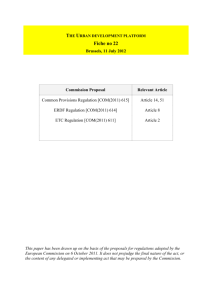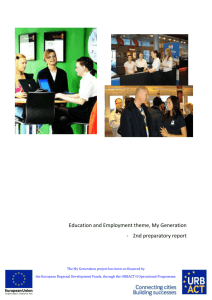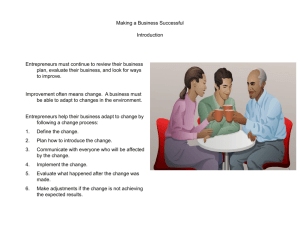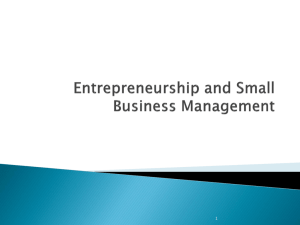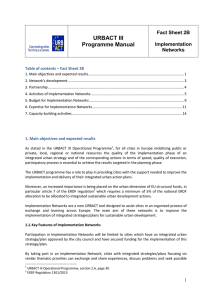Local Support Groups
advertisement
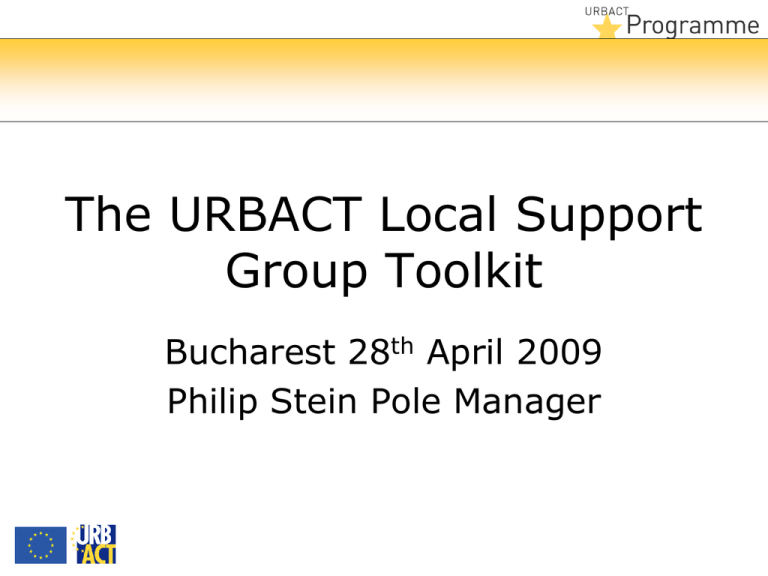
The URBACT Local Support Group Toolkit Bucharest 28th April 2009 Philip Stein Pole Manager 2 The URBACT Community 27 Projects 181 Cities 26 Member States 200 Managing Authorities Around 3000 members of local support groups A passive audience or a force for change? 3 Local Support Groups – Guidelines but no single recipe Nature of theme Who? Size + composition What? Role + activities 4 City context Local Support Groups – size and composition Anyone with a “stake”. Allies required for implementation Quality before quantity Around 10 people (in fact 4-43) Build on what exists Core group + broader groups End users? MA’s Animators 5 Local Support Groups – objectives and tasks Objectives • Identify needs • Identify + mobilise what the city has to offer • Project champion. From project to plan to action to project • Represent end-users • Communicate learning Tasks • 2 way conveyor belt for project learning – exchanges…. • Coproduction of outputs – LAP, case studies, reports…… • Ownership + championship – decision makers, funders… • Dissemination – media, meetings…… Working together better What happens in meetings is vital Meetings of equals Frequency + preparation Draw on participative techniques - facilitation Participation in exchanges, twinning, peer reviews, implementation labs Phases: trust + preparation, prioritisation + commitment, strategy, follow up . 7 Working apart better What happens outside and between meetings is just as important. Use the opportunities of IT and networking tools • Online file + project management • Skype • Teleconferencing • On-line training • W2 8 Local Action Plans Concrete road map of solutions to tackle core problems identified Local impact of transnational exchange. Transnational impact of local action. Form depends on: nature of problem and context (what exists + what is possible) Full blown independent plan or recommendations to an existing plan National, regional, city, neighbourhood, sector, research… 9 Fundable projects, Implications for OP, for broader urban policy Making an action plan • Review evidence base • Stakeholder analysis • Problems analysis • Goal to activities • Logical framework • Consultation on draft plan • Launch 10 Review the evidence base Review baseline and secondary sources EAP comments Policy mapping – what exists Identify what is working and what is not Make demands and draw on transnational exchange 11 Stakeholder Analysis Close to local support group Primary stakeholders – those directly affected Secondary – those with intermediary role – including delivery agencies Interest v power to influence Key (core) stakeholders - both Presence of users, beneficiaries… Absent friends How far can one go – issue + context 12 Dealing with conflict. Building on success… Problem analysis Brain storm all problems Identify core problems (trunk) – can vote Identify causes (roots) and effects (branches) Visualise and validate. 13 Goal to activities Establish a goal related to the problem identified. Observable measurable end result at a deadline Specific objectives Outputs Activities required for outputs Who, when, with what? 14 Logical Framework Analysis Check of: External consistency – relationship between problem and overall objectives (goal) Internal consistency – do activities lead to outputs which fulfill specific objectives which meet the goal Feasibility – financial and human resources Assumptions. Risk. Political changes, economic crisis, etc. 15 Consultation on draft plan There is a world outside the local support group Distinguish participation, consultation and communication Peer review by stakeholders Summary LAP Allow time Incorporate flexibility . 16 Launch Identify target audience Decide on timing – use other high profile events… Communication strategy Celebrate – make it fun. 17 Resources €7000 per LSG Translations Travel and accomodation Meeting rooms 18 1. The reference context City of Venice 2. Definition of the Local Action Plan Quantitative analysis Qualitative analysis Comparison and synthesis of the two phases European Policies Directorate, Social Policies Directorate, Trade and Economic development Directorate 3. The local action plan for the promotion of immigrant entrepreneurship Veneto Region Public Security and Migration Flows Director 4.Planning of an experimental training course for entrepreneurs MILE First Presentation Workshop, Enterprise Development for Migrants and Ethnic Minorities Brussels, 16 June 2008 19 1.2 Problem Analysis The quantitative analysis will be transferred in the territorial information system of the Venice City Council. The image of the distribution of the minorities in the community, can make easier the identification of public intervention areas. VENISE LIDO MESTRE MARGHERA Localisation of companies with a foreign owner in Mestre Localisation of companies with a foreign owner in Venice town centre 1. Venice: 2,318 enterprises with foreign owner (10.8% of the total enterprises) 2. In Venice 1,574 enterprises with foreign owner are individual entrepreneur or simple partnership (SAS and SNC) for a total of 1.737 locations 3. 92 % of these enterprises with foreign owner have been founded after 2005 4. Principal sectors: 31,3% commerce, 26,6% construction, 15,9% hotel & restaurant Project co-financed by ERDF within the URBACT Programme Brussels 16-17 June 2008 20 2.0 Overall aim and Specific objectives Overall aim: 1. To develop an integrated business support system aiming to the social inclusion of disadvantaged and under represented people with specific regard to immigrants Specific objectives: 1. To promote business culture and self entrepreneurship as a resource for personal and social development 2. To strengthen and to qualify non-financial support services for business start-up, growth and consolidation 3. To extend financial-economic promotion measures for business development 4. To foster networking of public and private resources for entrepreneurship promotion Project co-financed by ERDF within the URBACT Programme Brussels 16-17 June 2008 21 3.0 Main target groups 1. Italian and immigrant entrepreneurs and aspirant entrepreneurs 2. Trainers, tutors, business advisors 3. Chamber of Commerce, entrepreneurs associations, professional bodies, third sector organizations 4. Middle and secondary schools students "A me via Piave di più“ event, October 2007 "A me via Piave di più“ event, October 2007 Project co-financed by ERDF within the URBACT Programme Brussels 16-17 June 2008 22 5.0 Main (governance) principles of the action plan and of its implementation Entrepreneurship as an active tool for social inclusion of disadvantaged and under represented groups, with specific regard to immigrants Equal opportunities for all citizens in the access to business support services; but: 1. Services and tools customization according to the specific needs of immigrant users 2. Integrated business support strategy: - it considers organically the different stages of enterprise support: business culture promotion, support in the start-up phase, access to finance, consolidation and growth support; - complementarities between financial and non-financial business support. 3. Inter-departmental coordination and inter-institutional cooperation with the Veneto Region and key stakeholders for business promotion: Chamber of Commerce, entrepreneurs associations, professional bodies, third sector organizations. Towards a “Local pact for inclusive entrepreneurship” funded on the participation in the planning, implementation, monitoring and evaluation phases of local stakeholders 4. Municipality of Venice: in charge of the coordination and promotion of the local action plan and pact Project co-financed by ERDF within the URBACT Programme Brussels 16-17 June 2008 23 4.0 Activities to be undertaken Six areas of intervention: 1. Business culture promotion 2. Information and guidance 3. Training 4. Economic promotion 5. Knowledge of the social-economic situation 6. Coordination and networking 2. Information and guidance: a. Strengthening of the existing municipal information and advice service for entrepreneurs b. Customization of existing services to the needs of immigrant users; processing and spread of: • multi-language information tools • multi-media package for intercultural training and advice related to business support c. Improvement of on-line information for business development: increasing of cooperation with existing portals (www.venetoimmigrazione.it “) 1. Business culture promotion: a. Introduction of TAKTIX, the board game that learns how to run a successful business, in middle and secondary schools b. Radio programmes for the promotion of self-entrepreneurship through a multimedia platform managed by immigrants associations (to be created within FIVE Project) Project co-financed by ERDF within the URBACT Programme Brussels 16-17 June 2008 24 4.1 Activities to be undertaken 4. Economic promotion: a. Restoration of some spaces located at Forte Rossarol and their conversion into a business incubator for immigrant enterprises b. Agreement with foundations and financial institutions for the increase of subsidised financing for entrepreneurs and micro-credit for starter entrepreneurs c. Promoting and giving visibility to successful experiences, specifically related to equal opportunities, through the foundation and/or participation in prizes for successful entrepreneurs d. Regular multilingual information on local, national and European funding opportunities for business development 3. Training: a. Training programme for business start up and consolidation, targeting Italian and immigrant entrepreneurs (experimental training course project application for recent call for proposals within ESF ROP) b. Training programme for practitioners (trainers and tutors) and business advisors on intercultural training and cultural mediation methods Project co-financed by ERDF within the URBACT Programme Brussels 16-17 June 2008 25 4.2 Activities to be undertaken 5. Knowledge of the social-economic situation: 6. Coordination and networking: a. Community involvement and mediation project (« via Piave » project); a. (Possible) Setting up of a City interdepartmental technical long-lasting working group with the participation of the Veneto Region b. Research on immigrant entrepreneurial strategies; b. Creation and signing of a “Local pact for inclusive entrepreneurship” where activities and all signers’ commitments will be detailed c. Identification, analysis and diffusion of good practices at European level on “immigrant entrepreneurship”; c. Setting up of a mixed commission between the City and local socioeconomic stakeholders to monitor the implementation of the local action plan and local pact d. Geomapping of of Italian and foreign local enterprises in the Municipality of Venice website. Project co-financed by ERDF within the URBACT Programme Brussels 16-17 June 2008 26 6.0 Complementarities with other interventions Project co-financed by ERDF within the URBACT Programme Brussels 16-17 June 2008 27 Questions for workshops WORKSHOP 1 Composition of the Local Support Group • Are you sure you have the relevant stakeholders in your Urbact local Support Group? • How balanced is the group? Is it mostly municipality departments? What about other public agencies? Are NGOs involved? Is the private sector on board (where appropriate)? • Are there missing voices? Are users, or residents adequately involved? • Will the group be able to work effectively? • What barriers is the group likely to face in working effectively 29 WORKSHOP 1 How will the group link to the URBACT network meetings • Is the group meeting before and/or after network exchange meetings? • Is the group making demands on the network to help to solve its problems? E.g. In terms of issues to be discussed • Does someone from the group attend the network meetings? • What challenges does the group face in doing its work 30 WORKSHOP 2 Local Action Plans • What kind of local action plan is foreseen? • What is the anticipated involvement of the LSG in the production of the LAP • What are the steps towards the production of the Local Action Plan? • Are there existing plans that the LAP needs to build on? • How will you consult with other local stakeholders • Who will write the plan? (e.g. co-production) who will help them to write it? • Is the plan going to require funding for projects? • How will the Managing Authority be involved 31
